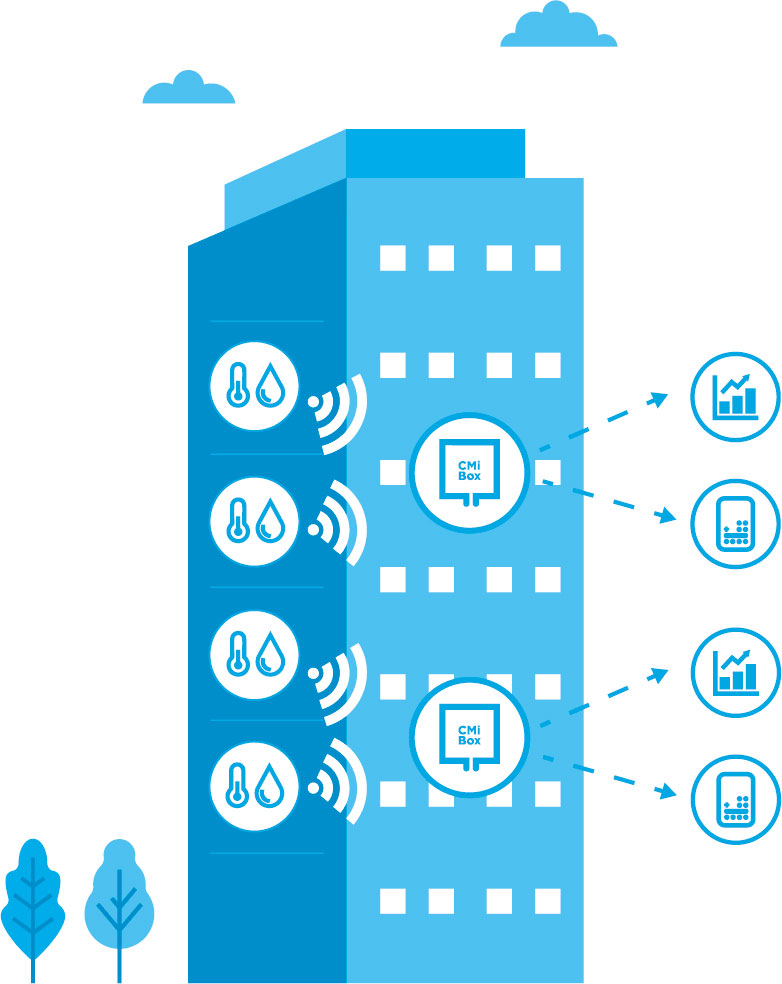Wireless M-Bus
Wireless M-Bus is the radio version of the M-Bus standard.
Data encoding is done in the same way as for M-Bus, but the data is instead transferred via radio on the unlicensed frequency band (868 MHz in Europe). Wireless M-Bus is used for remote reading of, for example, meters for electricity, water, heat, and temperature. The supply of various M-Bus meters and equipment is very large, and because the communication protocol and the electrical interface are regulated by an EN standard, equipment from different manufacturers can easily be mixed into customized systems.


Standard and compatibility
The M-Bus standard defines how communication should work from the radio layer all the way up to including how the actual data is formatted. This means that all M-Bus compliant equipment works well together and that there is no extra product specific information required to interpret or operate M-Bus equipment from a protocol perspective.
Data acquisition and reading with wireless M-Bus
Just like the classic M-Bus system, the wireless version also works according to a master-slave concept. A central unit, the so-called M-Bus master, controls numerous subordinate units, the slaves, which supply the master with data. This creates clear communication channels and dependencies between the individual actors within the infrastructure. A wireless M-Bus system can comprise several hundred slaves, which record specific sensor values, for example relating to energy consumption, but also to temperature and humidity.
The slaves send their collected data to the master at the frequencies 868 MHz and 434 MHz, without any cabling. Since the selected frequencies are license-free values, the license fees for data transmission are waived. When the wireless M-Bus master arrives, the data supplied by the slaves is collected, processed and made available to the operator for evaluation.
Technical performance
Wireless M-Bus offers all the advantages of using M-Bus standard equipment but without the requirement of cabling. As with all radio technologies using the unlicensed frequency bands it can suffer from interference of other radio devices – all transmitters compete for the same resource “air time” when transmitting – and damping of the signal caused by physical objects between sender and receiver. Compared to other radio solutions, Wireless M-Bus offers medium range and penetration (ability to pass through physical objects) and care need to be taken when doing the radio planning. Often some sort of repeaters must be deployed to “clean-up” spots that do not have coverage from the receiver. Messages from meters/sensors that are lost due to e.g. radio conditions are typically considered to be non-recoverable.
Bandwidth is low but well adapted for sending frequent messages with sensor or meter data while still offering excellent battery performance, well above 10 years for a single AA sized cell. In contrast to wired M-Bus, receivers can also be battery powered although the active “receive time” per day needs to be constrained to reach reasonable battery lifetime.
For Wireless M-Bus systems, it is also important to understand that (practical) range is depending on the resolution needed. Typically, Wireless M-Bus meters and sensors transmit their data several times per hour. Depending on if the receiving system requires a high reliability of receiving at least one message per hour for each meter/sensor or if one message per day is sufficient, the practical range between meters/sensors and receivers will be very different.
Both Wired and Wireless M-Bus supports
- Two-way communication, but systems are for technical reasons, most often thought of as “one way”, from the meter/sensor to a receiving system.
- Encrypted meter/sensor data
Suitable applications
Wireless M-Bus is typically deployed when an M-Bus solution is wanted but the cost of cabling is too high or unpractical. This could, for example, be the case for retrofit of an individual building as well as when used for collection from a larger area with many buildings.
From wireless M-Bus receiver to suitable sensors
Elvaco has been using wireless M-Bus technology for many years to provide an uncomplicated and cost-effective alternative to the classic, wired M-Bus. With the wireless M-Bus receiver CMeX50 and the CMi Box receiver, we have developed a professional and powerful solution for managing and controlling up to 800 M-Bus meters. Our range of wireless M-Bus technology is rounded off by a range of compatible meters and sensors.


 Subscribe to our newsletter
Subscribe to our newsletter